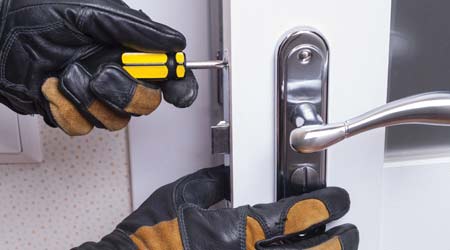 Managers can match door hardware selections to the previously assesses security requiremnts and the door's location.
Managers can match door hardware selections to the previously assesses security requiremnts and the door's location.Selecting The Proper Door Hardware
Part two of a two part series on door hardware security
Inadequate duty selection
Managers need to match door hardware selected for a particular application to the durability requirements of that application. Fortunately, a series of standards can help managers throughout this process. Rating procedures developed by ANSI and BHMA give door hardware a grade based on the number of cycles that it can be expected to withstand in a typical application. Grade 1 hardware has the longest service life and Grade 3 hardware has the shortest.
For example, a Grade 1 butt hinge should be able to withstand 2.5 million cycles, while a Grade 3 butt hinge should be able to withstand 350,000 cycles. Those ratings do not mean managers always should specify Grade 1 hardware. Grade 1 components might last longer, but their costs can be 50 percent more than those of similar Grade 3 components.
Installing a Grade 1 component in a relatively low-use application would increase installation costs with no return benefit. Installing a Grade 3 hardware component in a high-use application would increase maintenance costs and decrease the level of security due to wear and tear and possible early component failure. It is important for managers to understand the requirements of the particular application in order to specify the most appropriate hardware.
With the ANSI and BHMA constantly reviewing product standards, managers can take advantage of those standards for a range of door hardware components. The demand for improved building security has led to the development of new technologies, materials and improved manufacturing techniques. This change, in turn, has led to the development of door hardware components that exceed Grade 1 standards. If considering one of these components, managers must verify the component was properly tested according to the established procedures.
Lack of standardization
When a door hardware component fails, not only are building occupants and visitors inconvenienced. Building security is compromised. For that reason, managers must respond quickly to incidents. A quick response requires that maintenance technicians know ahead of time the type of hardware that has been installed and the procedures to use in adjusting or replacing it. Just as importantly, maintenance technicians must have ready access to replacement inventory, which can only happen through standardization.
Consider what happens without standardization. Technicians have to go to the site and determine the type of hardware installed. If a component needs adjustment, hopefully they have been trained to perform it correctly. If replacement is required, the technician has to determine exactly the part needed and see if it is in stock. If it is not, the technician must pick it up locally or order it. The net result is a delay in completing the necessary repairs, and the delay might compromise security.
In contrast, standardization can reduce the time necessary to complete repairs or replacement of door hardware components. Just as importantly, standardization will reduce costs. By standardizing on a series of door hardware components, departments can stock commonly used replacement components. Since fewer types of hardware are in use, stocking requirements and costs are reduced. Maintenance technicians can be trained on the required maintenance and replacement procedures for that line of components, which also reduces costs and time.
Standardization does not mean that the exact same components will be installed on all doors in a facility. Hardware components differ based on the level of service and security required for a particular application. Standardization means the range of components used is much smaller.
Related Topics:















